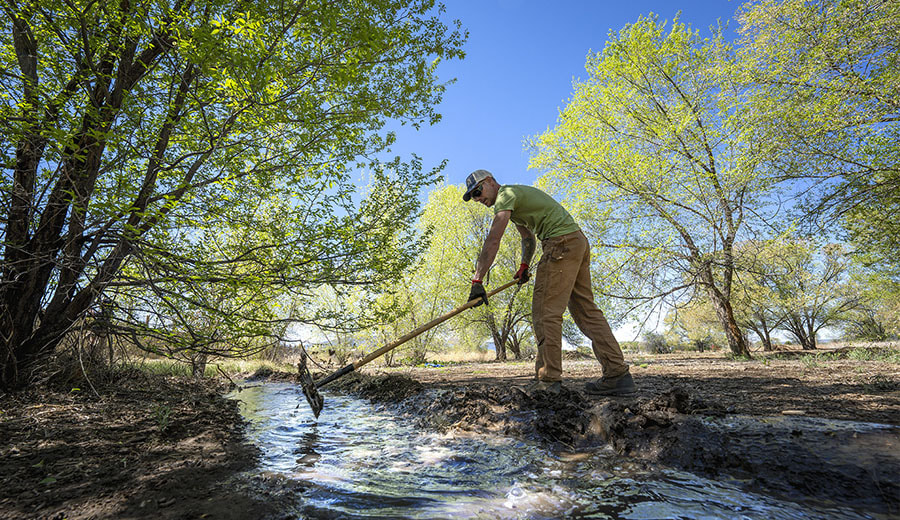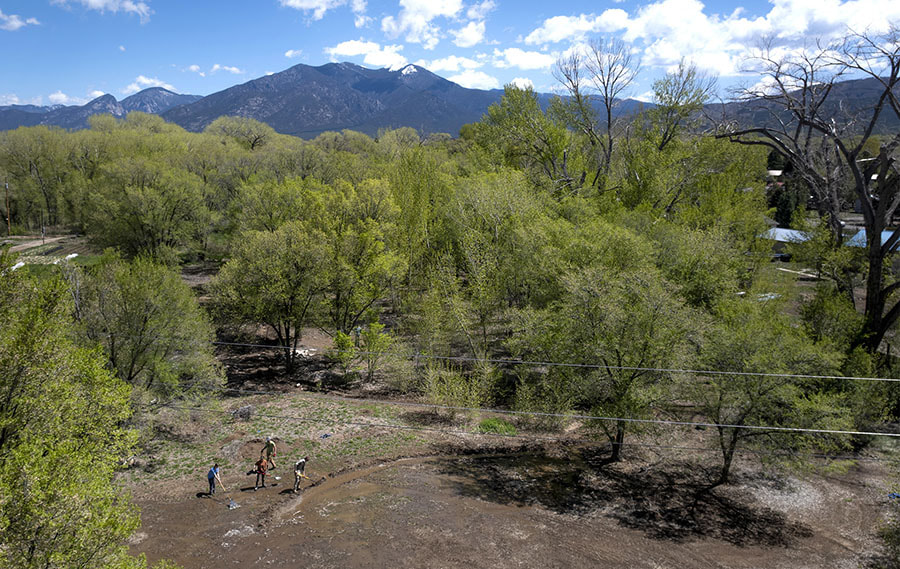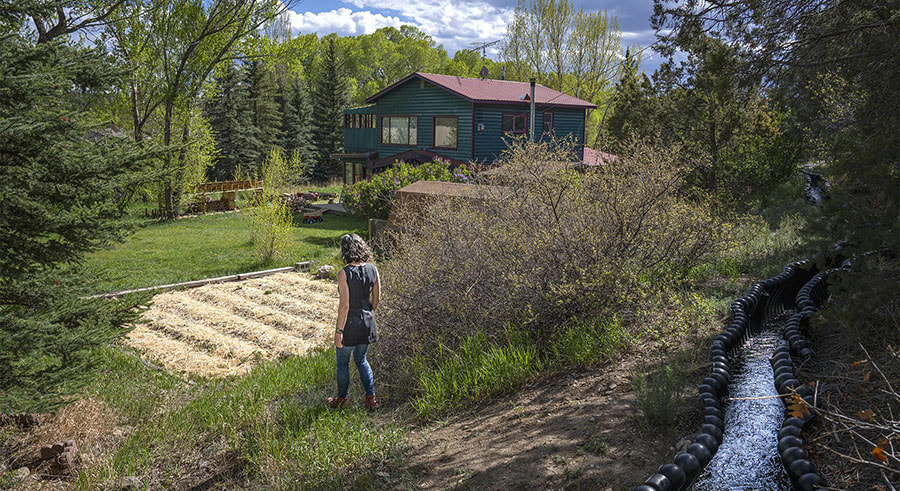|
Water and wildfire risk reduction brings communities together with a common focus Tracy Farley and Zachary Behrens Office of Communication and Carson National Forest This is the second of two stories featuring the Carson National Forest’s Enchanted Circle Landscape, part of the USDA Forest Service’s Wildfire Crisis Strategy, which focuses on water restoration and wildfire risk reduction. Read part one. “’Water Is life,’ like everybody says, but when you actually get into it, it's true,” said Ames Austin, Mayordomo for the Vigil y Romo Acequia on the southwest end of Taos, New Mexico. “It is one of the most important aspects of our existence, and it's the main way we revitalize the land and grow food for ourselves in such an arid, dry desert. It brings life to the land.” In the high desert of Northern New Mexico, water is everything. Because of the unique historic cultural system of irrigation ditches, or acequias, communities can fully use the snowpack from the upper elevations on the Carson National Forest. The ongoing wildfire risk reduction work on the Enchanted Circle Landscape not only provides a healthier forest, but also can potentially increase the amount of water that flows downstream to family farms and communities. “It is very important that we make sure our acequia is ready for when the snow comes down. We keep an eye on that snowpack to know how long we have irrigation for, when we can plant our crops, what types of crops we can plant and how long we can keep those plants going,” said Ames. “We need that snowpack runoff to come down and then be diverted into our acequia to water our crops so we can plant gardens and bring together our community. Because we live in this dry basin, it's a really big deal.” Reviving the Vigil y Romo AcequiaAmes and his parciantes, who are members of an acequia that hold water rights, are working to revive the Vigil y Romo Acequia, which was in disuse for years. One of their first missions is weed mitigation. Acequia law requires that all persons with irrigation rights participate in the annual maintenance of the community ditch including the annual springtime ditch cleanup, known as the limpieza y saca de acequia. “The cover crops will eventually choke out those noxious weeds and then create a forest of green shrubbery, as opposed to a bunch of weeds and a dry field,” said Ames. One of Ames’s parciantes is Jim Johnston and his colleagues at the Taos Land Trust, where he is the working lands director. He said the food grown at the trust’s Rio Fernando Park ends up in a local high school’s lunch program. Bringing the Community Together The Rio Fernando Collaborative is another example of how the community has joined together to use water originating from the Enchanted Circle Landscape. Maya Anthony manages this group of agencies, organizations, nonprofits and individuals in Taos County that work together for the improvement of the Rio Fernando de Taos that runs through the center of town and the broader Rio Fernando watershed. “Seeing where people interface with that river and ecosystem and how many different trails and agricultural interests are along this river; it's a vital part of the community,” said Maya, standing next to the acequia that runs through her backyard in San Cristobal, NM. “I'm helping bring the group together and facilitate some of our work through having a joint issue that truly unites the community around some shared goals for this river and watershed.” “From a personal standpoint, having federal agencies, along with nonprofits and different community members in the area, it's just nice to see those conversations happening in some way. People may have disagreements, but they are working through it to a point where we can all work together,” said Maya. The collaborative is working through a water smart grant from the Department of the Interior’s Bureau of Reclamation that is helping the group plan and implement restoration efforts.“We're using nature’s tools as a way to enhance the ecosystem that hopefully creates more ways to store water higher up and release water more slowly throughout the year,” explained Maya. “Benefiting agriculture is very high up there on the list for us, because there is such a deep importance and connection to the land through agriculture. Our water-sharing models of this community in the southwest are of vital importance for us to protect.” “With less water, there comes a lot of challenges, but finding ways to keep the fabric of community at the forefront of this is what I think makes the collaborative strong and is something that we're looking at as one of our strengths,” continued Maya. “Hopefully that benefits the community, to see where the efforts are going and see more creative water storage and stormwater infrastructure.” Water is life- Carson National Forest Enchanted Circle shows the synergy of collaboration with a multitude of partners about reducing wildfire risk and providing life giving water coming from snowpack on the forest, supplying families, schools and communities with food, water, fuelwood. Members of the Taos Land Trust Rio Fernando Park are no different than others in their community, as they flood their field with water from the nearby acequias, a traditional irrigation ditch, to get their crops growing with much needed hydration. (USDA Forest Service photo by Preston Keres)  Water is life- Carson National Forest Enchanted Circle shows the synergy of collaboration with a multitude of partners about reducing wildfire risk and providing life giving water coming from snowpack on the forest, supplying families, schools and communities with food, water, fuelwood. Members of the Taos Land Trust Rio Fernando Park are no different than others in their community, as they flood their field with water from the nearby acequias, a traditional irrigation ditch, to get their crops growing with much needed hydration. (USDA Forest Service photo by Preston Keres) Water is Life
“The communal acequia model of bringing water throughout communities and centering around days or nights that you get water for whatever you would like to use on your land has a really special place in my heart,” said Maya. “It's very special seeing how people just get together around that. And it breaks down barriers between fences and property boundaries. There's very much a collective sense of, ‘This water is for everybody.’ And we try and share it as best we can with the water that's available." “Water is life,” said Maya. “It serves as a humbling reminder of our humanity and how much it connects us and how much we are in a position to protect that fragile balance as much as we can. If we can see ourselves as part of something, then we realize and appreciate water as not just something that comes out of the tap every time you want, but it really holds such a vital balance.”
0 Comments
Your comment will be posted after it is approved.
Leave a Reply. |
Submit your ideas for local feature articles
Profiles Gardening Recipes Observations Birding Essays Hiking AuthorsYou! Archives
October 2025
Categories
All
|




 RSS Feed
RSS Feed